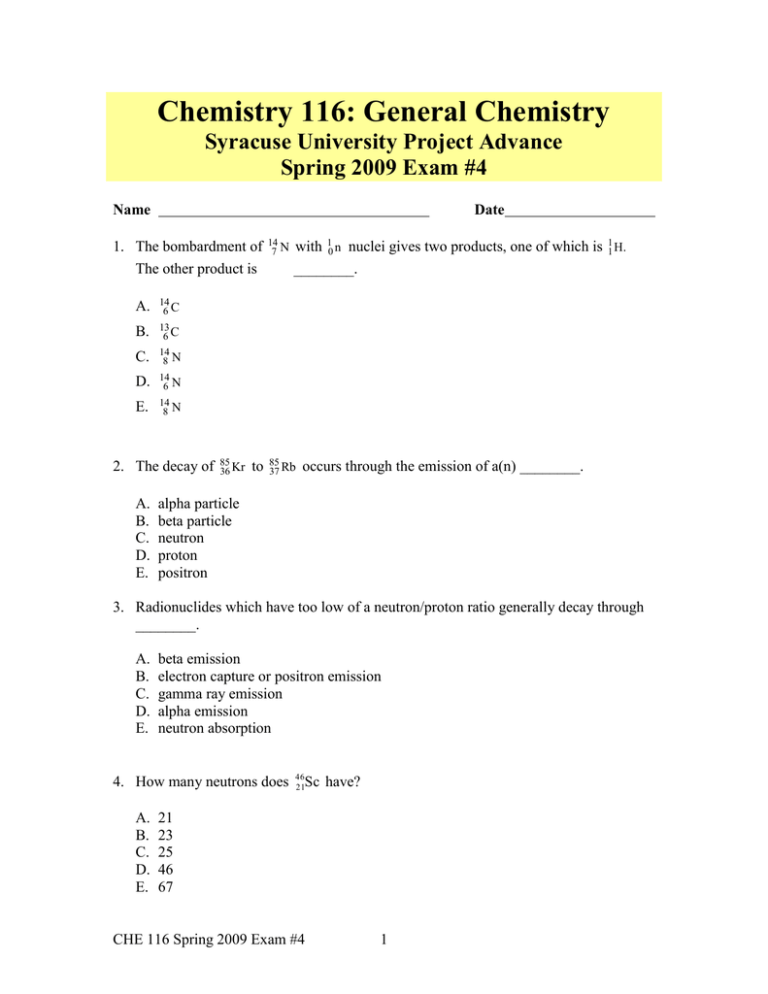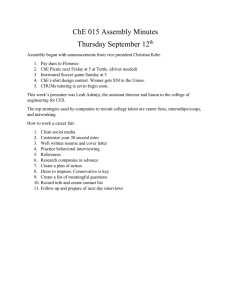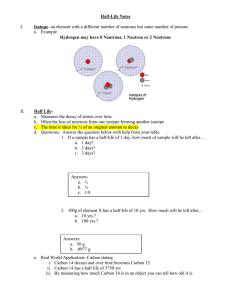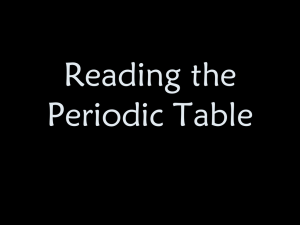Chemistry 116: General Chemistry Syracuse University Project Advance Spring 2009 Exam #4
advertisement

Chemistry 116: General Chemistry Syracuse University Project Advance Spring 2009 Exam #4 Name Date 1. The bombardment of The other product is A. 14 6C B. 13 6C C. 14 8N D. 14 6N E. 14 8N 2. The decay of A. B. C. D. E. 85 36 Kr to 14 7N with 10 n nuclei gives two products, one of which is 11 H. ________. 85 37 Rb occurs through the emission of a(n) ________. alpha particle beta particle neutron proton positron 3. Radionuclides which have too low of a neutron/proton ratio generally decay through ________. A. B. C. D. E. beta emission electron capture or positron emission gamma ray emission alpha emission neutron absorption 4. How many neutrons does A. B. C. D. E. 21 23 25 46 67 46 21 Sc have? CHE 116 Spring 2009 Exam #4 1 5. Identify the missing product in the following nuclear reaction: 238 92 U _______ + 42 He A. B. C. D. E. 242 94 234 90 242 90 234 92 232 92 A. B. C. D. E. 47.6 h 53.4 h 58.0 h 63.0 h 71.2 h Pu Th Th U U 6. Analysis of a 4.50-mg sample of a newly discovered isotope showed that only 3.25 mg of the isotope remained after 29.6 h. What is the half-life of the isotope? 7. An atom with 15 protons and 18 neutrons is an isotope of A. B. C. D. E. argon arsenic chlorine phosphorus sulfur 8. The nuclide symbol -10 e represents a(n) A. B. C. D. E. electron proton neutron positron gamma photon 9. A positron has the same mass as A. B. C. D. E. a gamma ray a neutron an alpha particle a proton a beta particle CHE 116 Spring 2009 Exam #4 2 10. When 235 92 U is bombarded with one neutron, fission occurs. The products are two neutrons, 144 55 Cs , and A. B. C. D. E. 139 56 90 37 143 55 89 37 94 36 Ba Rb Cs Rb Kr 11. The radiation that has the highest penetration power is A. B. C. D. E. gamma. beta. positron. X-ray. alpha. 12. The total number of protons and neutrons in the nuclide 37Cl is (a) (b) (c) (d) (e) 54 37 20 17 35.45 13. The nuclear reaction (a) (b) (c) (d) (e) 14 6C ------> 14 7N + 0 -1 e is an example of nuclear fusion nuclear fission natural transmutation artificial transmutation none of the above 14. In 6.20 hours, a 100 gram sample of an isotope decays to 25.0 grams. What is the half-life, in hours, of this isotope? (a) (b) (c) (d) (e) 1.6 3.1 6.2 12.4 18.6 CHE 116 Spring 2009 Exam #4 3 15. The main purpose of a moderator in a fission reactor is to (a) (b) (c) (d) (e) emit neutrons absorb neutrons slow down neutrons speed up neutrons create neutrons 16. In a first-order reaction the half-life is 11.6 minutes. The rate constant, k, in s-1 is (a) (b) (c) (d) (e) 1 x 10-3 1 x 10-4 700 1000 2000 17. Atoms with a given number of protons, but with a different number of neutrons are called (a) Isomers (b) Isotones (c) Isotopes (d) Isochrones (e) Ionofores 18. Which equation is an example of artificial transmutation? (a) 238 92U ------> 42He + (b) 27 (c) 14 (d) 226 88Ra 13Al 6C + 4 2He ------> 14 ------> 234 90Th 30 15P ------> 7N 4 + 2He 0 + 1 0n -1e + 222 86Ra 19. Fissionable uranium-233, uranium 235, and plutonium-239 are used in nuclear reactors as (a) coolants (b) control rods (c) moderators (d) fuels CHE 116 Spring 2009 Exam #4 4 20. Which reaction illustrates fusion? (a) 2 + 2 (b) 1 + 27 (c) 27 13Al + (d) 14 1H 0n 7N + 1H ------> 13Al 2He ------> 4 2He 4 2He 4 24 11Na + 4 30 15P + 1 0n ------> ------> 1 1H 2He + 178O 21. The nuclear equation: 14 7N + 1 0n --------> 14 6C + ? can be balanced by adding to the right side (a) one proton (b) one gamma (c) one positron (d) one electron (e) one alpha 22. What happens to the mass number and the atomic number of an element when it undergoes beta decay? A) neither the mass number nor the atomic number change. B) the mass number decreases by 4 and the atomic number decreases by 2 C) the mass number does not change and the atomic number increases by 1 D) the mass number does not change and the atomic number decreases by 2 E) the mass number increases by 2 and the atomic number increases by 1 23. The correct name of the following compound is O A. B. C. D. E. 2-pentaketone methyl propyl ether 2-quinone 2-pentanone methyl butanoate CHE 116 Spring 2009 Exam #4 5 24. What is the IUPAC name for the following compound? H3C H C H2C A. B. C. D. E. CH2 CH C H2 CH3 4-ethyl-1-pentene 2-ethyl-4-pentene 4-methyl-1-hexene 3-methyl-5-hexene 2-(2-propenyl)butane 25. Which functional group does NOT contain an oxygen atom? A. B. C. D. E. ketone alkyne aldehyde ester alcohol 26. The compound NH2 is classified as a CH3 CHCH2CH2CH3 A. B. C. D. E. primary amide. secondary amide. tertiary amide. secondary amine. tertiary amine. 27. How many hydrogen atoms are needed to complete the following hydrocarbon structure? A. B. C. D. E. C C C C 4 5 6 8 10 CHE 116 Spring 2009 Exam #4 6 28. While alkenes and alkynes readily undergo hydrocarbons do not. Instead they undergo A. B. C. D. E. reactions, aromatic reactions. addition, substitution elimination, substitution substitution, elimination substitution, addition addition, elimination 29. List, in order (i) through (iv), the functional group for each of the following compounds: (i) CH3 O CH2CH2CH3 (iii) HO H (ii) 1. 2. 3. 4. CH3 N C CH2CH3 O amide aldehyde alcohol carboxylic acid (a) (b) (c) (d) (e) (iv) 5. ester 6. ketone 7. ether 2, 1, 3, 7 7, 2, 3, 6 7, 1, 4, 2 5, 6, 4, 2 3, 1, 5, 2 30. The IUPAC name for the compound shown below CH3CH2 H (a) (b) (c) (d) (e) C C CH2CH3 H is cis-3-hexene. is trans-3-hexene is trans-3-hexyne is cis-3-hexyne is none of the above CHE 116 Spring 2009 Exam #4 7 H O C CH2 CH3 O C CH2CH3 31. Which of the following compounds has the greatest possible number of isomers? (a) (b) (c) (d) (e) butane ethane pentane propane methane 32. Which compound can exist as cis and trans isomers? (a) (b) (c) (d) (e) 1,1-dibromomethane 1,2-dibromoethene 1,1,2-tribromoethene 1-bromo-1-chloroethene 1-butene 33. Which one of the following could be a cyclic alkane? A) B) C) D) E) C5H5 C3H6 C4H6 C2H6 C9H20 34. The addition of HBr to 2-butene produces A) B) C) D) E) 1-bromobutane 2-bromobutane 1,2-dibromobutane 2,3-dibromobutane no reaction is observed 35. The empirical formula of an addition polymer is A. B. C. D. E. the same as the empirical formula of its monomer. the empirical formula of its monomer less 2H. the empirical formula of its monomer less 2H and O. the empirical formula of its monomer plus 2H. the empirical formula of its monomer plus 2H and O. CHE 116 Spring 2009 Exam #4 8 36. The monomer unit for polypropylene is propene. What is the formula for the repeating unit of this polymer? CH3 (a) C H2 (d) C H2 C C H C F2 C F2 CH3 (b) C H (e) C H CH3 CH3 (c) C H C H 37. The polymerization of ethylene (C2H4) to form polyethylene occurs by a(n) (a) (b) (c) (d) (e) addition reaction. condensation reaction. copolymerization reaction. esterification reaction. transesterification reaction. CHE 116 Spring 2009 Exam #4 9





